Hackettstown, New Jersey Revolutionary War Sites (original) (raw)
- HOME
- •
- TIMELINE
- •
- ABOUT
- •
- FAQ
- •
- READ THE BOOK!
This website, its text and photographs are © 2009 - 2025 AL Frazza. All rights reserved.
- Atlantic County
- Bergen County
- Burlington County
- Camden County
- Cape May County
- Cumberland County
- Essex County
- Gloucester County
- Hudson County
- Hunterdon County
- Mercer County
- Middlesex County
- Monmouth County
- Morris County
- Ocean County
- Passaic County
- Salem County
- Somerset County
- Sussex County
- Union County
- Warren County

OLD PRESBYTERIAN BURIAL GROUND

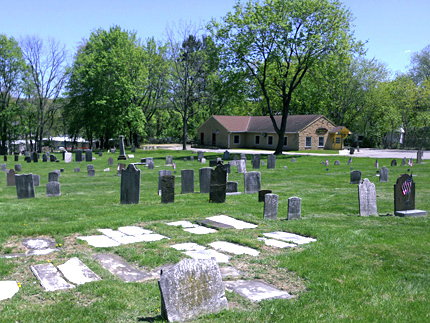
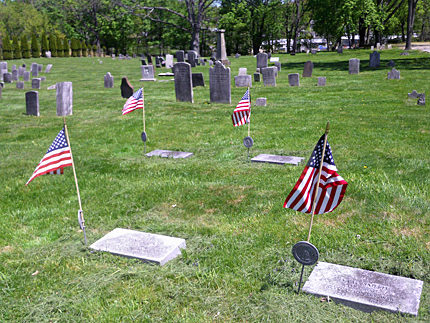
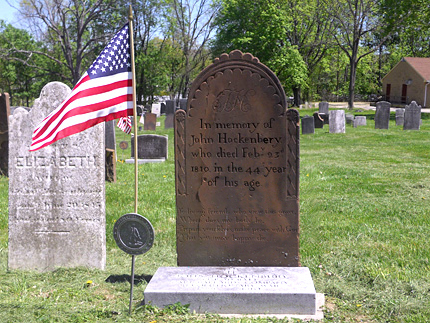
Old Presbyterian Burial Ground
291 Main St.
Map / Directions to the Old Presbyterian Burial Ground
Map / Directions to the all Hackettstown Revolutionary War Sites
The Old Presbyterian Burial Ground is currently the subject of an ongoing restoration project. An article about the restoration can be found here. For more information, contact Charles Prestopine at 908-852-5941.
The Old Presbyterian Burial Ground is next to the First Presbyterian Chapel. This cemetery contains the graves of 29 Revolutionary War soldiers: [1]
Ezekiel Ayers 2nd
Ensign,
Sussex County Militia
Obadiah Ayers
Private,
Middlesex County
Conover Bowne
Private;
Lt. Clyde Regiment, Brown Company
Joseph Campbell
Private; First Battalion, Second Establishment
Robert Caskey
Private; Continental Line
John Clark
Private;
Second Battalion, Second Establishment:
Captain Hendry's Company, Second Regiment
James Cook
Colonel, Morris County
Edward Dunlop
Paymaster
John Hance
Private
First Battalion, Second Establishment;
Captain Forman's Company, First Regiment
John Hockenbery
Private
Captain Ballard's company, Third Battalion, Second Establishment
Also militia
Greshon Hull
Captain
Fourth Regiment, Hunterdon
John Kemple
Private
Graham Regiment, Hermance Company
William Lawrence
Private
Essex County
Also: Matross, Captain Neil's Eastern Company Artillery, State Troops
William Morgan
Member of Captain Helm's 9th Company, 2nd Regiment of the New Jersey Line
John Patrick
Private
Crane Regiment, Lockwood Company
Jacob Phillips
Private
Captain Martin's Company, Fourth Battalion, Second Establishment
Jeremiah Pool
Wagoner
Continental Line
John Robertson
Private;
Morris County
John W. Schenck
Captain;
Third Regiment, Hunterdon County
Jacob Sharp
Private
Fisher Regiment, Snook Company
Isaac Smith
Colonel
1st Regiment, Hunterdon County
Archibald Stewart
Private
Webster Regiment, Company Long
John Stewart
Sergeant
Eastern Battalion, Morris County Militia
Robert Stewart
Corporal, Captain Bonds Company
Samuel Stewart
Private
McCrea Regiment, Doty Company
William Stewart
Private
Captain Bonds Company, 4th Battalion;
Joseph Sutton
Private
3rd Regiment, Hunterdon Company
John Vliet
Major,
1st Battalion, Somerset County
William Wire

SITE OF THE HOME OF ROBERT WILSON AND MARTHA STEWART WILSON
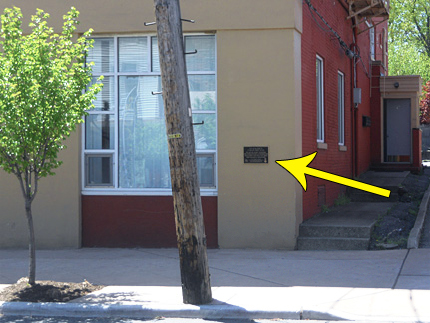
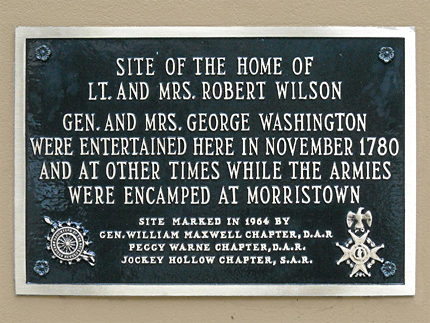
Lt. Robert Wilson House Site
176 Main St.
Map / Directions to the Robert Wilson House Site
Map / Directions to the all Hackettstown Revolutionary War Sites
Robert Wilson was an Irish immigrant who became a successful merchant in Philadelphia. Wilson had joined the army after news of the Battles of Lexington and Concord in Massachusetts, the first battles of the Revolutionary War. When George Washington was named Commander in Chief of the Continental Army by Congress in Philadelphia in June 1775, Wilson was one of the officers who accompanied General Washington on his trip to take command of the army in Cambridge, Massachusetts. After a brief period of service as muster-master-general, Wilson's poor health led him to leave the army.
In January 1776, he married Martha Stewart. the daughter of Colonel Charles Stewart, who served as George Washington's Commissary-General of Issues. In 1777, Robert and Martha Wilson purchased property in Hackettstown and lived in a house that was located at this site. Robert died in 1779 at the age of twenty-eight; Martha was left a widow at twenty. Because of her father's position in the Army, Martha met and entertained many important Revolutionary War figures, both in Hackettstown and at her father's house in Hunterdon County. These include George Washington, Alexander Hamilton, Marquis La Fayette, Nathaniel Green, Horatio Gates, William Maxwell and Casimir Pulaski.
Martha's life spanned an interesting period. She was born December 20, 1758, eighteen years before the signing of the Declaration of Independence. She died at age 93 on March 15, 1852, just nine years before the start of the Civil War. Shortly before turning 90, she was interviewed by author Elizabeth F. Ellet for her 1848 book, The Women of the American Revolution. Ellet wrote a thirty-page chapter about Martha based on these interviews, including Martha's experiences during the war. The following visit to George Washington to Hackettstown in 1780 is described:
"With General Washington [Martha] was on terms of friendship. She first met him in Philadelphia, in 1775, when he was preparing to join the army at Cambridge. He afterwards visited her at different times at her residence in Hackettstown; on the last occasion a year after her husband's death, and a short time after the execution of Major André [which occurred October 2, 1780]. His approach with Mrs Washington and his staff, under the escort of a troop of horse, was privately announced to Mrs. Wilson in time to have dinner in readiness for a party of thirty or forty persons. To one whose patriotism was so decided, it must have been a pleasure indeed, thus to welcome to her roof and table the leading spirits of the land. The party did not leave till after luncheon on the second day; and knowing that they could not reach their destination till late at night, ample provision was made from her larder and wine cellar, to furnish all needed by the way.
"Before these distinguished guests took their departure, a large concourse of people from the adjacent country and the towns in the vicinity had crowded round the house to catch a glimpse of the idolized Chief. A few members of the legislature and the prominent gentlemen of the neighborhood were admitted and formally introduced. Among these was Dr. Kennedy, the family physician, whose salutation as Mrs. Wilson well recollects, was: 'I am happy indeed to meet the man whom under God, I deem the saviour of our country.' As it was impossible for the multitude to obtain entrance, a little stratagem was devised by one of the gentlemen, by which those without could be gratified without subjecting the General to the annoyance of a mere exhibition of himself. Knowing his admiration of a fine horse, he ordered an animal remarkable for its beauty to be brought into the street, and then invited him out to inspect it. Thus an opportunity was afforded to the whole assemblage to gaze upon and salute him with their cheers." [2]
Source Notes:
1. ^ Information about the 29 soldiers was sent to me by Charles Prestopine, who is working on the cemetery restoration. I would like to thank Charles for taking the time to speak with me and mail me the information.
• For more information about Charles Prestopine and his work on the cemetery, see the article:
Tommy Rowan, "Hackettstown Cemetery has 29 American Revolution Veterans' Headstones Restored," The Express-Times, July 09, 2012. Available online here.2. ^ Information for this entry was drawn primarily from:
Elizabeth F. Ellet, The Women of the American Revolution, Volume II (New York: Baker and Scribner, 1848) p. 37-67
Available to be read at the Internet Archive here
▸ Ellet makes it clear that she had personally interviewed Martha, who was then nearly 90 years old, for her information. In the first paragraph of her chapter about Martha, Ellet wrote:
"One of the representatives of those times, in which America must ever feel pride, is yet living at the Lakelands, Lake of Otsego, near Cooperstown, New York. She not only retains an accurate and vivid recollection of scenes in the stormy and fearful infancy of the nation on whose vigorous manhood she is permitted to look, but has kept pace in intellectual cultivation, with the advancement of modern days. The grasp of mind that apprehends and appreciates the progress of her country's prosperity and power, gives a deeper interest to her thrilling recital of incidents belonging to its struggle for life. I am particularly favored in having received from her various anecdotes of persons with whom she was intimately acquainted at that period, her reminiscences of whom would form a most valuable contribution to the domestic history of the Revolution."
▸ The text quoted about Washington's visit appears on page 45 and 46.
▸ Ellet's book contains thirty pages about Martha, and so is recommended to those who would like to read more about her.• Ellet's book gives the date of Martha's birth but not her death, because she was still alive when the book was published. The March 15, 1852 date for her death appears in the book:
Winslow M. Watson, A Family History: Johnson, Stewart, Wilson, Bowers (Washington D.C.: Gibson Brothers, 1872) p. 11
Available to be read at Google Books here
▸ This book bears the following dedication: "To The Descendants of Mrs. Martha Wilson, Woman of the Revolution, this family history is respectfully inscribed by the compiler, Winslow M Watson"• The plaque on the building was placed in 1964 by the General William Maxwell Chapter, D.A.R.; the Peggy Warne Chapter, D.A.R.; and the Jockey Hollow Chapter, S.A.R.